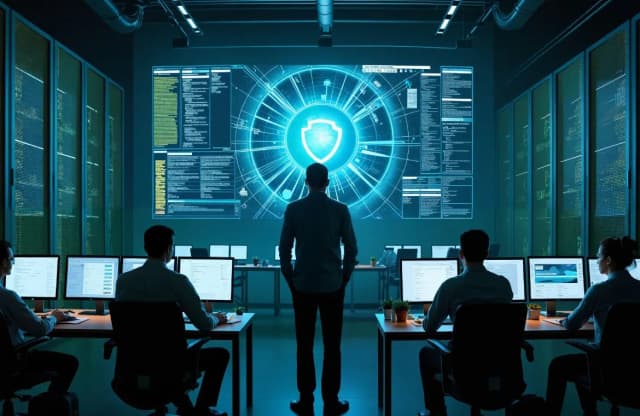What Is Artificial Intelligence in Cybersecurity?

“Unlike firewalls that follow static rules, AI systems learn from behavior, adapting with every new threat.”
AI in cybersecurity is changing how organisations defend their digital assets against increasingly sophisticated threats. Security systems powered by AI can analyse massive data sets, identify patterns, and make informed decisions faster than humans ever could. This technology has become essential to modern security strategies and provides unmatched protection as threats continue to evolve.
From AI-powered phishing detection in Gmail that blocks 99.9% of malicious emails, to machine learning firewalls predicting zero-day threats, AI has become the invisible force field that keeps our digital lives safe.
What is Artificial Intelligence in Cyber Security?
AI in cybersecurity uses smart algorithms and machine learning to boost the protection of computer systems, networks, and data from cyber threats. These systems are different from regular software.
They copy human thinking, learning, reasoning, and spotting patterns. They process huge amounts of data to make defences stronger through automation, up-to-the-minute data analysis, and threat prediction.
AI cybersecurity systems build secure applications from the ground up. They spot issues with high accuracy, speed up investigations, and respond to threats automatically. The systems learn from new data constantly.
This helps them spot and alleviate new threats, cut down false alarms, and scale up security more efficiently.
Also Read: What is Cyber Security? The Truth About Online Safety
How is AI different from traditional cybersecurity tools?
Traditional cybersecurity tools mainly use signature-based detection. These tools compare incoming network traffic with a database of known threats or malicious code signatures. This method works well against known threats but fails with new (Zero-Day) or unknown threats. It also tends to raise too many false alarms.
Why is AI becoming essential in modern threat landscapes?
In today’s hyper-connected world, cyber threats evolve faster than humans can react. Every click, login, or cloud upload creates a new entry point for attackers, and traditional security tools simply can’t keep up. This is where Artificial Intelligence (AI) steps in, not as a luxury, but as a necessity in modern cybersecurity.
AI acts like a digital immune system, constantly learning, adapting, and strengthening defences. Unlike rule-based systems that only respond to known threats, AI can detect patterns, anomalies, and subtle deviations in real time, often before a human analyst even notices something’s wrong.
The ai in cybersecurity market in India is expected to reach a projected revenue of US$7,716.4 million by 2030. A compound annual growth rate of 36.3% is expected of India AI in the cybersecurity market from 2025 to 2030.
The Role of AI in Modern Cybersecurity Frameworks
Modern cybersecurity frameworks employ artificial intelligence to build strong defence systems. AI has transformed these frameworks beyond their traditional methods. Security systems now adapt and respond more quickly to threats.
1. Threat detection and prevention
AI spots both known and emerging threats through advanced pattern recognition and anomaly detection. These systems can spot suspicious activities that humans might miss by analysing huge amounts of security data.
The systems watch network traffic, user behaviour, and system logs to catch signs of compromise as they happen.
2. Real-time incident response
AI systems jump into action with preset responses when they detect threats, based on the danger level and possible damage. Organisations can contain incidents quickly before they spread.
AI-powered responses include isolating infected devices, stopping malicious traffic, and preventing malware from spreading. Teams can react faster because AI handles these crucial first steps automatically.
3. Predictive cyber intelligence
AI's ability to predict attacks might be its most game-changing feature in cybersecurity. The systems look at past attacks, new trends, and global threat data to forecast potential future attacks.
AI finds possible weak spots and attack paths before criminals can use them. These systems can also test different attack scenarios through adversarial machine learning. Security teams discover weaknesses early.
4. Fraud detection and risk assessment
AI has changed how we catch fraud by checking millions of transactions for suspicious patterns. Machine learning models learn from past data to catch and block fraud attempts instantly.
AI chatbots study language patterns and user behaviour to catch scammers during conversations. This layered approach protects against many different types of attacks.
Benefits of AI in Cybersecurity
AI in cybersecurity brings game-changing advantages to organisations that want to strengthen their defence systems. AI technologies process huge datasets and learn from every interaction, providing benefits that traditional security methods simply can't match.
Speed and efficiency: Real-time analysis of vast data volumes
AI security systems can process massive amounts of data at incredible speeds. These systems complete analyses in seconds that would take human teams weeks to finish.
Accuracy: Reduces false positives through pattern learning
Security teams face a big challenge with false alarms. About half of security alerts turn out to be false positives. AI systems fix this problem by learning normal patterns and telling real threats from harmless activities.
Scalability: Handles large enterprise networks without manual intervention
Networks have become too complex for manual monitoring. AI shines at scaling security across huge enterprise systems, cloud setups, and distributed networks without needing more staff.
Cost-effectiveness: Reduces the need for constant human supervision
The money-saving benefits of AI in cybersecurity are clear. AI security automation also helps with the shortage of cybersecurity experts by handling routine tasks, which lets specialists focus on strategic work.
Continuous learning: AI models improve with every new threat detected
AI systems keep getting better through machine learning, unlike traditional security tools. They use replay buffers, regularisation techniques, and growing architectures for effective learning.
Challenges and Ethical Considerations
AI shows impressive capabilities in cybersecurity, yet it faces big challenges and ethical issues that need careful attention. The technology's advancement creates a paradox - as it grows more sophisticated, associated risks increase too.
Adversarial AI: Hackers using AI to outsmart defensive systems
Adversarial AI attacks pose a growing threat that targets machine learning models' operation. Traditional cyberattacks exploit software vulnerabilities, but adversarial attacks manipulate data and the model's decision-making process. Attackers tap into the subtle weaknesses of AI systems' logic through crafted inputs.
Bias in training data: Risks of incomplete or skewed datasets
AI systems depend on human-provided data but lack empathy to spot wrong details. This limitation shows up as bias when training data or algorithms have flaws, which leads to false positives and negatives affecting results. Biased AI models might flag harmless activities as threats.
Privacy concerns: AI's access to large volumes of sensitive data
AI systems use massive amounts of information, which creates unprecedented privacy challenges. Training data includes terabytes or petabytes of text, images, and video. Sensitive information like healthcare records, personal finance data, and biometric identifiers inevitably become part of this data. This raises concerns about data misuse, hidden collection methods, and algorithmic profiling that could discriminate against users.
Human oversight: Importance of balancing automation with human judgment
AI systems need human supervision, similar to guiding a junior analyst. AI might outperform humans in some tasks, but humans understand the broader context of operations and spot potential risks better.
Also Read: Top Cybersecurity Threats and how to deal with them in 2025?
Future Trends: The Evolution of AI-Driven Cybersecurity
AI in cybersecurity continues to evolve faster with state-of-the-art solutions that will redefine digital protection strategies. These advances will build more resilient security infrastructures through intelligent, automated, and ethical approaches.
Generative AI for threat simulation and detection
Generative AI has altered the map of security through sophisticated threat simulation techniques. Security teams now use generative adversarial networks (GANs) and variational auto-encoders to simulate realistic cyber-attacks and strengthen defence mechanisms. This method improves threat detection and response times better than traditional approaches and builds the foundation for adaptive security frameworks.
AI-powered automation in SOC operations
Security Operations Centres (SOCs) now employ AI to transform their capabilities. AI-driven platforms reduce the average threat detection and containment time to under an hour. These systems group multiple alerts into a single incident automatically. This cuts investigation time and helps analysts focus on genuine risks through machine learning-based incident scoring.
Predictive analytics for proactive defence
Predictive analytics marks a transformation from reactive to proactive security postures. Organisations can anticipate and reduce potential threats before they materialise by analysing statistical and machine learning patterns. Effective predictive models use richer contextual features, including user behaviour, asset criticality, and temporal patterns. This enables better early detection and optimised resource allocation.
Integration with cloud and IoT security
AI improves IoT security through immediate threat detection, access control, authentication mechanisms, and vulnerability identification. Organisations can monitor subtle activities across complex installations and pursue adaptive responses through machine learning algorithms.
Ethical AI and transparency in cybersecurity tools
Ethical considerations have become central to AI cybersecurity implementation. Organisations must keep AI models transparent and audit training data regularly through diverse teams to reduce bias. Human oversight remains essential; AI should increase security professionals' capabilities rather than replace them.
Conclusion
As we move deeper into an AI-driven era, one thing is clear: cybersecurity can no longer rely on human speed alone. The threats are faster, stealthier, and constantly evolving. Artificial Intelligence bridges that gap, turning reactive defence into proactive digital resilience.
AI doesn’t just detect threats; it learns, adapts, and predicts them. From stopping phishing attacks before they hit your inbox to identifying insider threats hidden deep within networks, AI has redefined what “smart protection” truly means. It empowers security teams to respond in seconds, not hours, transforming cybersecurity from a defensive measure into a strategic advantage.
Frequently Asked Questions
Q1. How does AI enhance cybersecurity compared to traditional methods?
AI in cybersecurity analyses behaviour patterns rather than just matching signatures, enabling faster threat detection and reducing false positives. It can process vast amounts of data in real-time, adapt to evolving risks, and automate responses, making it significantly more efficient than traditional approaches.
Q2. What are the main benefits of using AI in cybersecurity?
The key benefits include faster threat detection (up to 60% quicker), improved accuracy with fewer false positives (up to 85% reduction), enhanced scalability for large networks, cost-effectiveness through reduced human supervision, and continuous learning to adapt to new threats.
Q3. Can AI completely replace human cybersecurity professionals?
No, AI cannot completely replace human cybersecurity professionals. While AI excels at data analysis and pattern recognition, human oversight remains crucial for understanding broader contexts, making strategic decisions, and addressing ethical considerations in cybersecurity operations.
Q4. What are some challenges associated with AI in cybersecurity?
Challenges include adversarial AI attacks, potential bias in training data, privacy concerns related to handling large volumes of sensitive information, and the need to balance automation with human judgment. Additionally, there's the risk of AI-powered attacks like deepfakes and sophisticated phishing scams.
Q5. How is AI shaping the future of cybersecurity?
AI is driving innovations like generative AI for threat simulation, AI-powered automation in Security Operations Centres, predictive analytics for proactive defence, and enhanced integration with cloud and IoT security. There's also a growing focus on ethical AI and transparency in cybersecurity tools to ensure responsible implementation.

TalentSprint
TalentSprint is a leading deep-tech education company. It partners with esteemed academic institutions and global corporations to offer advanced learning programs in deep-tech, management, and emerging technologies. Known for its high-impact programs co-created with think tanks and experts, TalentSprint blends academic expertise with practical industry experience.



